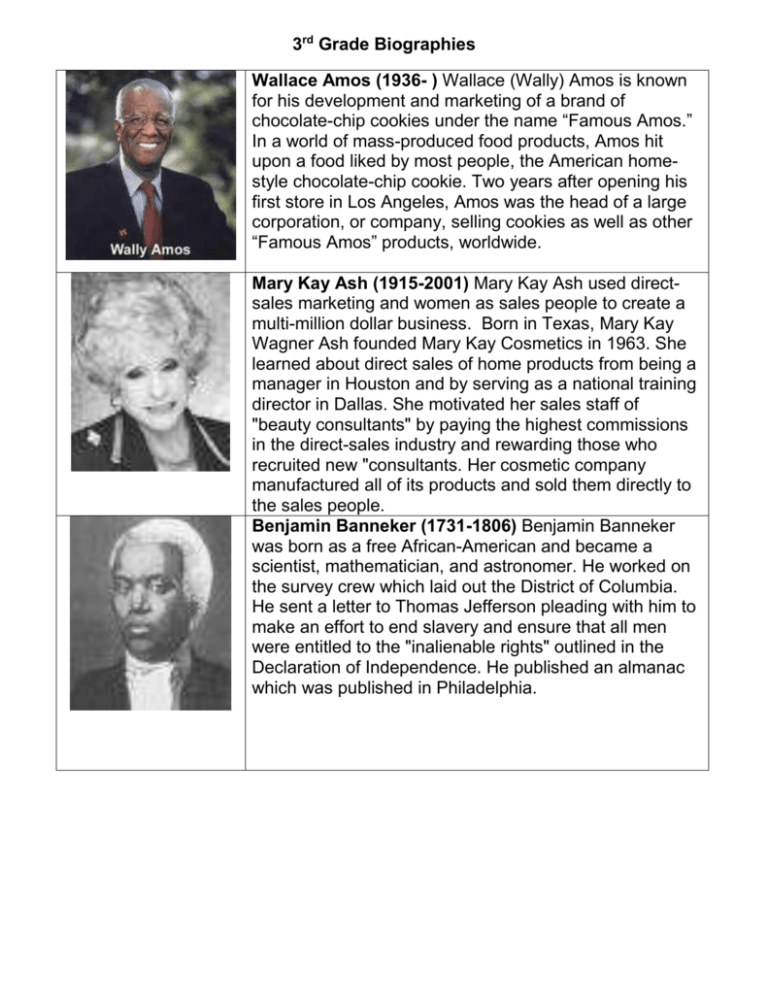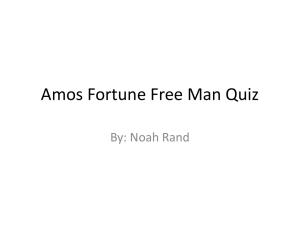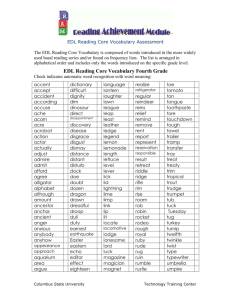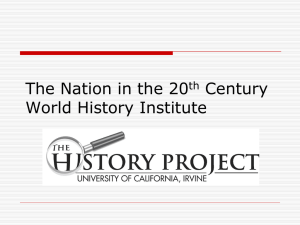3rd Grade Biographies
advertisement

3rd Grade Biographies Wallace Amos (1936- ) Wallace (Wally) Amos is known for his development and marketing of a brand of chocolate-chip cookies under the name “Famous Amos.” In a world of mass-produced food products, Amos hit upon a food liked by most people, the American homestyle chocolate-chip cookie. Two years after opening his first store in Los Angeles, Amos was the head of a large corporation, or company, selling cookies as well as other “Famous Amos” products, worldwide. Mary Kay Ash (1915-2001) Mary Kay Ash used directsales marketing and women as sales people to create a multi-million dollar business. Born in Texas, Mary Kay Wagner Ash founded Mary Kay Cosmetics in 1963. She learned about direct sales of home products from being a manager in Houston and by serving as a national training director in Dallas. She motivated her sales staff of "beauty consultants" by paying the highest commissions in the direct-sales industry and rewarding those who recruited new "consultants. Her cosmetic company manufactured all of its products and sold them directly to the sales people. Benjamin Banneker (1731-1806) Benjamin Banneker was born as a free African-American and became a scientist, mathematician, and astronomer. He worked on the survey crew which laid out the District of Columbia. He sent a letter to Thomas Jefferson pleading with him to make an effort to end slavery and ensure that all men were entitled to the "inalienable rights" outlined in the Declaration of Independence. He published an almanac which was published in Philadelphia. Clara Barton (1821-1912) Clara Barton taught school for several years and then became the first woman to work in the federal government. She worked in the Patent Office. During the Civil War, she realized the troops did not have adequate health care. While her friend, Dorothea Dix, worked on organizing nurses, Barton worked on organizing donations and collecting and distributing supplies to the doctors and nurses. In 1865, with President Abraham Lincoln's support, she opened an agency to search for missing soldiers and marked the graves of those who died during the war. After the war, she visited Europe and learned about the International Red Cross. She supported its cause. When she returned to America, she asked Congress to start an American Red Cross and for the government to give support. This was granted in 1882. Todd Beamer (1968-2001) Todd Beamer was a passenger on Flight 93. The plane crashed on September 11, 2001, because of the attacks by terrorists, people who try to harm a country and its people. He was on the phone when he learned that the World Trade Center had been attacked using hijacked airplanes. Beamer reported by phone the actual events of what was happening on the plane. He told the operator that he and other passengers were planning to "jump on" the hijackers. Many people believed that the passengers crashed the airplane to save the lives of others on the ground. Others believed that the passengers fought with the terrorists over the controls for the plane. He is considered a hero because of his courageous efforts. Daniel Boone (1734-1820) Daniel Boone opened the Kentucky frontier to settlement from the east by surveying land, opening the Wilderness Road, fighting Indians, and building settlements. Wherever Boone went, a settlement was started. He spent his life exploring the frontier. His real life accomplishments made him popular during his lifetime. His adventures were symbols of the changes in America from an independent, rugged frontier to a modern nation. Boone is a real figure of national significance, but he is also known as a folk hero. This is partly because of the exaggerations, or the stretching of the stories, of his abilities and experiences. Ruby Bridges (1954- ) Ruby Bridges played an important role in the Civil Rights Movement. Ruby was born in 1954 in Mississippi, but later moved to New Orleans, Louisiana. Ruby Bridges was a young black girl who decided to go to an all-white school during a time when some people believed that white and black people should be kept separate. When Ruby went to school, no white parents would allow their children to be in the same classroom with her. This meant she was the only one in her class. Her class was even on a different floor from all the other students. She had one person she could depend on at school. Her teacher, Mrs. Henry, was very loving toward her and taught her each day. She helped Ruby through the difficult times that she had at school. Christopher Columbus (1451-1506) Christopher Columbus was born in Italy and was a navigator and explorer. Columbus believed the world was round. In 1492 he led a voyage which landed in the West Indies. King Ferdinand and Queen Isabella of Spain gave Columbus money to buy ships to sail and explore to the west. His ships were the Pinta, Niña, and the Santa Maria. After a 37-day voyage, he landed in present-day San Salvador on October 12, 1492. He thought he had reached the East Indies. The significance of Columbus' discovery is remembered every Columbus Day, a federal holiday on the second Monday of October. Tomie dePaola (1934- ) Tomie dePaola is an author and illustrator. He has published about 200 children's books in fifteen different countries. He is considered one of the most popular creators of books for children. His love of books came from his mother reading to him everyday when he was young. He is the author of The Legend of the Bluebonnet. Henry Ford (1863-1947) Henry Ford helped to create a country which is mobile by mass producing and marketing the Model T automobile. Through his efforts, the automotive industry became world-wide. As a young boy, Ford worked on a farm, at a shipbuilding firm, and for a company which serviced steam engines. During the winters he worked at building his own engines. He built and drove his first automobile in 1896. The Ford Motor Company was founded in 1903, and he developed the Model T by 1908. Ford used mass production to reduce the price of the Model T, and he worked to perfect the assembly line. Founding Fathers Founding Fathers is the general name given for all male American patriots during the Revolutionary War. The name specifically refers to the signers of the Declaration of Independence and those who drafted the Constitution. John Adams, Benjamin Franklin, Alexander Hamilton, Thomas Jefferson, James Madison, and George Washington were all considered Founding Fathers. Benjamin Franklin (1706-1790) Benjamin Franklin was a well-known printer in Philadelphia and an active leader in the city. He published Poor Richard's Almanack which shared bits of wisdom in shaping American character with the readers. He founded the first library and fire department in America. As an inventor he proved that lightning was a form of electricity and he also invented bifocal glasses, lightning rods, and the Franklin stove. In his political roles, Franklin helped write the Declaration of Independence and the U.S. Constitution. He spent most of his time during the Revolutionary War in France negotiating the alliance with France and then the Treaty of Paris which ended the war. He also participated in the U.S. Constitutional Convention in 1787 and earned the distinction as being the oldest delegate in attendance. Hector P. Garcia (1914- ) Hector García founded the G.I. Forum, one of the most active and successful civil rights organizations for Mexican-Americans. Although he was born in Mexico, he grew up in South Texas with his family and was educated there. He earned a medical degree from the University of Texas at Austin. Garcia served in the U.S. Army Medical Corp during World War II and received the Bronze Star. He founded the American G. I. Forum to protect the rights of Mexican-American veterans and helped them receive financial and medical benefits from the Veterans Administration. García was politically active as a member of the state and national Democratic Party committees. He was awarded the U.S. Medal of Freedom in 1984. Carmen Lomas Garza (1948- ) Carmen Lomas Garza is an artist and author. Her expertise is evident in her paintings and other works as they reflect her rich family and cultural heritage. She was the first Mexican-American artist to have a solo exhibition at the Hirshhorn Museum and Sculpture Garden in Washington, DC. Carmen Lomas Garza has published two books for children. Both are filled with paintings of her childhood memories. The text in her books is written in both English and Spanish. One of her well-known books is Family Pictures. Bill Gates (1955- ) Bill Gates grew up with the computer industry. He became a leader through the widespread use of his own product, Microsoft. He was born in Seattle, Washington, and attended Harvard University before starting his company in 1976. He is considered a leader in the evolution of the computer industry. He has been considered one of the wealthiest men in the world, but he has given money to many charities and organizations as well as to scientific research. Although he is no longer C.E.O. of the Microsoft Corporation, he is busy with the Bill and Melinda Gates Foundation. Milton Hershey (1857-1945) Milton Hershey worked at several jobs as a young boy and became an apprentice at a young age. He learned all he could about the candy business and tried to create his own. He was not successful in his first several attempts. He finally created a caramel candy which was successful, and then his milk chocolate candy became popular. Ever since Milton Hershey introduced the Hershey milk chocolate bar to the world in 1900, he never had to look back. His business grew, and he developed a “company town.” He is known for his candy and his generosity of providing a school for orphaned boys. Helen Keller (1880-1968) When she was a baby of nineteen months, Helen Keller lost her sight and hearing due to a fever. Her mother refused to let Helen give up and sought expert advice and treatment. Anne Sullivan became her lifelong teacher and companion. The "teacher" taught Helen how to communicate by sign language, read with Braille, and write with a special typewriter. Keller earned a degree from Radcliffe College and published two books. She was active in supporting the right for women to vote, supported the American Foundation for the Blind, and was a symbol of courage and capability to the world. She received the Presidential Medal of Freedom in 1964. Pierre-Charles L’Enfant (1754-1825) Pierre-Charles L'Enfant was born in France, but he lived in the United States and designed its government buildings. He fought in the American Revolution and served as the captain of engineers for a time. L'Enfant converted the Old City Hall in Philadelphia to the Federal Hall. When Washington, D.C., was chosen as the site of the new capital, President Washington asked L'Enfant to design the city. Although L'Enfant was dismissed because he overspent the budget, his ideas and plans are seen in the layout of the White House and the Capitol James A. Lovell (1928- ) James Lovell was in the U.S. Navy and then joined NASA to be an astronaut. He is recognized for his bravery. He was the commander of Apollo 13. When the spaceship had a malfunction, or something that goes wrong, he safely led his crew back to Earth with the help of the Mission Control. He has received the Congressional Space Medal of Honor and the Presidential Medal of Freedom. Juliette Gordon Low (1860-1927) Juliette Gordon Low founded the Girl Scouts of America in 1912. As a young girl, she was very artistic and talented. She was also witty. When she grew up, she wanted to devote her time to something that she felt was worthwhile. She found this in Europe when she met the leader of the Boy Scouts. She then returned to America and founded an organization for girls, the Girl Scouts of America. Bill Martin Jr. (1916-2004) Bill Martin, Jr., was truly "America's favorite children's author." He wrote for almost 60 years. He was the author of the classic text, Brown Bear, Brown Bear, What Do You See? He also wrote over 300 other books for children including I Pledge Allegiance, a book about the pledge to the U.S. flag and what it means. As a tribute to Bill Martin, Jr., the Kansas Reading Association established an award in his honor. One picture book is honored each year and presented Bill Martin Jr., Picture Book Award. Cyrus McCormick (1809-1884) Cyrus McCormick was the son of a farmer/blacksmith/inventor. He used his talents to invent, improve, manufacture, and market of a successful mechanical reaper. The reaper was used to cut the grain, bind it, and stack it in the fields. Before the reaper, a farmer could only plant as much wheat as he could harvest because it ruined easily. The reaper allowed farmers to plant more wheat. Reapers and other machines caused a change in farming because mechanical instruments were need to make life easier for farmers. Maria Mitchell (1818-1889) Maria Mitchell was taught by her astronomer father. She was the first professional woman astronomer in the United States and became a professor of astronomy at Vassar College. She was the first woman to be a member of the American Academy of Arts and Sciences. She served as president of the American Association for the Advancement of Science. Kadir Nelson (1974- ) Kadir Nelson is an illustrator who starting drawing pictures at the age of three. His artwork is captured in numerous award-winning picture books, including Henry's Freedom Box by Ellen Levine and Abe’s Honest Words by Doreen Rapport. He received the Coretta Scott King Award for his illustrations in Moses: When Harriet Tubman Led Her People to Freedom by Carole Boston Weatherford. In 2008 he wrote and illustrated his first book, We Are the Ship: The Story of Negro League Baseball. He enjoyed writing the book so much that he plans to write more. Ellen Ochoa (1958- ) Dr. Ellen Ochoa is a veteran of three NASA Space Shuttle flights. She has logged over 719 hours in space, traveling four million miles in one mission alone. Before NASA selected Ellen to become an astronaut, Ellen proved herself on Earth by getting a doctorate degree in electrical engineering and co-inventing three patents for optical engineering systems. John “Danny” Olivas (1965- ) John “Danny” Olivas was an astronaut until he retired in May 2010. He was born in California but grew up in El Paso, Texas. Before he became an astronaut, he worked at Dow Chemical Company as a mechanical engineer. At NASA, he was a STS-117 mission specialist. He participated in the first planned session of extravehicular activity (EVA). Juan de Oñate (ca. 1550-1626) Juan de Oñate was a Spanish explorer. He is considered the founder of the first European settlements in the upper Rio Grande Valley, including the city of El Paso. Oñate led campaigns against Indians along the northern frontier of Mexico and prospected for silver. He aided in the establishment of missions in newly conquered territory. Louis Pasteur (1822-1895) Louis Pasteur discovered that heat could kill bacteria. This helped people realize why liquids such as milk spoiled. His discovery introduced the field of microbiology. He proved that the growth of bacteria resulted from germs in the air. The process of heating bacteria to kill them is known as "pasteurization." Pasteur also invented a vaccine to counter the effects of rabies. Pasteur directed the Pasteur Institute to the research of rabies until his death. Jonas Salk (1914-1995) Jonas Salk was a doctor who found a vaccine for polio. When Salk went to college, he planned to be a lawyer. His gained an interest in medical science and then decided to become a physician. While he was in medical school, he researched the flu virus. He wanted to know if the virus could be stopped from infecting people. He was successful and used this knowledge to help with a discovery of the polio vaccine. With this discovery of it, he became world famous over night. Harriet Tubman (ca. 1820-1913) Harriet Tubman was a slave who escaped to the North for freedom. Once she was free, she led more than 300 slaves to freedom over the next ten years. She used a system called the Underground Railroad to help others to get to freedom. She owned property in upstate New York. Her parents and other refugees lived there. Tubman was a spy and scout for the Union troops during the Civil War. After the war she opened a home on her farm in New York for elderly African-Americans. She attended the women's rights meetings in Seneca Falls. The first Black Heritage postage stamp had a picture of Harriet Tubman on it. Sam Walton (1918-1992) Sam Walton was the founder of two American retail stores, Wal-Mart and Sam's Club. He was father of the Walton family, one of the richest families in the world. In 1962 the first Wal-Mart store opened its doors in Rogers, Arkansas. It became a huge success and was the world’s largest retail store chain. By 2004, the number of people working for the Wal-mart Corporation was 1.5 million. Sam Walton was named by Time Magazine as one of the top 100 most influential people of the 20th Century. He also received the Presidential Medal of Freedom for his pioneering efforts. Walton was once considered the richest man in the U.S. Wal-Mart also operates Sam’s Club warehouse stores. Phillis Wheatley (1753-1784) Phillis Wheatley is known as the first African-American poetess and the first AfricanAmerican woman to have her works published. Her work is highly looked upon, today. It marks the beginning of African-American literature. She is well-known for her poem about the first U.S. President, George Washington. Laura Ingalls Wilder (1867-1957) Laura Ingalls Wilder was the author of the classic "Little House" book series. These were stories of her life and the places where she had lived. She wrote because she wanted to keep the tales of that time in American history. She wrote about the pioneer days she remembered about growing-up on the Midwestern frontier in the 1870s and 1880s. Laura wrote eight books about her time on the frontier. These books have been loved so many that a television series was based on her books.








